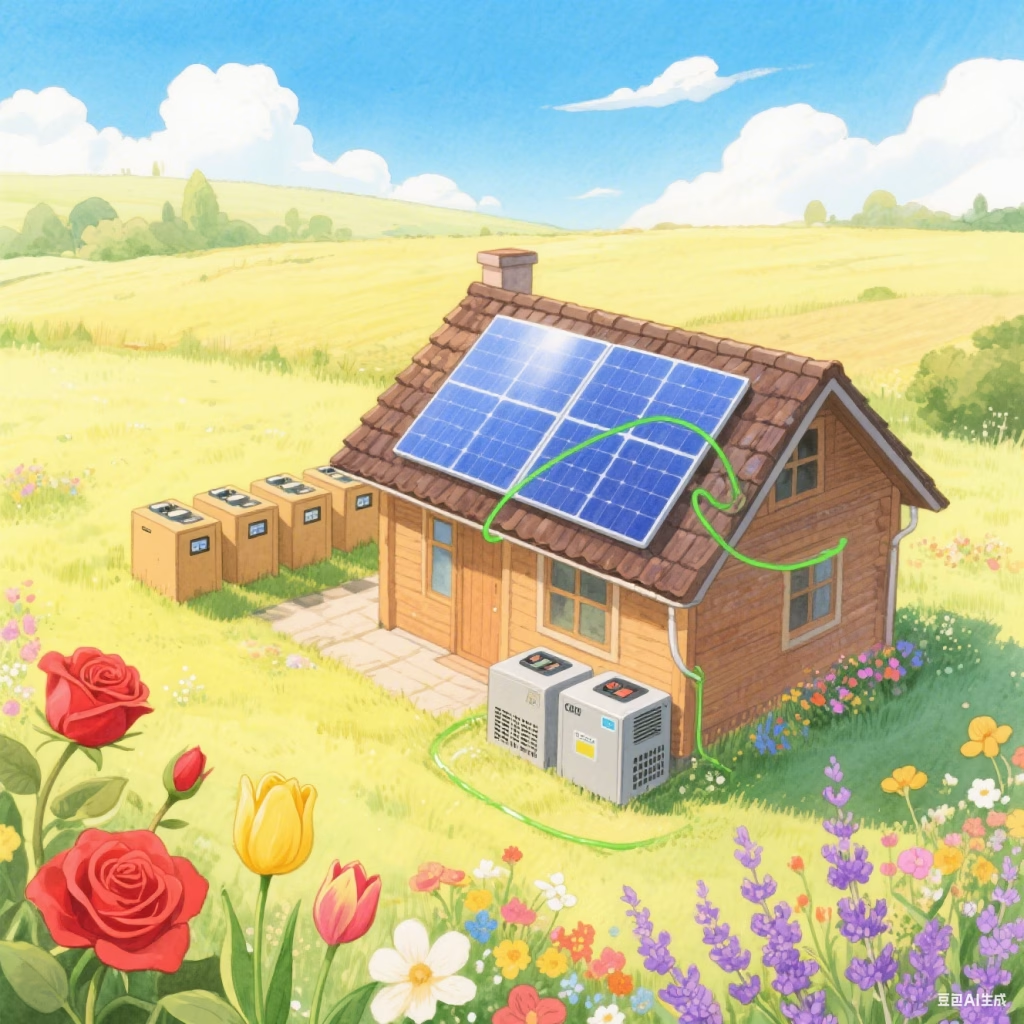Off-Grid Solar Power System,How to Choose?
In an era where sustainable energy solutions are not just a trend but a necessity, off-grid solar power systems have emerged as a viable and reliable option for many. Whether you’re powering a remote cabin, an RV for your adventures, or looking to achieve energy independence for your home, choosing the right off-grid solar power system is crucial. This comprehensive guide will walk you through the key considerations, components, and factors to keep in mind when making this important decision.
Understanding Off-Grid Solar Power Systems
An off-grid solar power system is designed to operate independently of the traditional electrical grid. It generates, stores, and distributes electricity solely from solar energy, providing a self-sufficient power supply. The basic components of an off-grid solar power system typically include solar panels, a charge controller, a battery bank, an inverter, and electrical wiring and connections. Each component plays a vital role in the overall functionality and performance of the system, and a mismatch or improper selection of any part can significantly impact the system’s efficiency and reliability.
Key Components and Their Selection Criteria
Solar Panels
Solar panels are the heart of any solar power system, converting sunlight into direct current (DC) electricity. When choosing solar panels for your off-grid system, several factors need to be considered:
Power Output
The power output of solar panels is measured in watts (W). You need to calculate your daily energy consumption to determine the total wattage required. Consider the electrical appliances and devices you plan to power, their wattage ratings, and the average hours of use per day. For example, if you have a 100W refrigerator that runs for 24 hours, a 60W LED TV used for 4 hours, and a few 10W LED lights used for 6 hours, your total daily energy consumption can be calculated as follows:
Based on the average sunlight hours in your location (which can vary widely depending on your geographical area), you can then estimate the number of solar panels needed to meet this demand.
Based on the average sunlight hours in your location (which can vary widely depending on your geographical area), you can then estimate the number of solar panels needed to meet this demand.
Efficiency
Solar panel efficiency refers to the percentage of sunlight that the panel can convert into electricity. Higher efficiency panels can generate more power in the same amount of space, which is especially important if you have limited roof or ground area for installation. While high-efficiency panels may come at a higher cost, they can offer better long-term value, especially in regions with limited sunlight.
Type of Solar Panel
There are mainly three types of solar panels: monocrystalline, polycrystalline, and thin-film. Monocrystalline panels are the most efficient and have a sleek, uniform appearance but are also the most expensive. Polycrystalline panels are less efficient but more affordable, making them a popular choice for many residential and small-scale off-grid systems. Thin-film panels are flexible and lightweight, suitable for curved surfaces or applications where weight is a concern, but they generally have lower efficiency and a shorter lifespan compared to the other two types.
Durability and Warranty
Since solar panels are exposed to various weather conditions, it’s essential to choose panels with high durability. Look for panels that are certified for weather resistance, such as those with a high wind and snow load rating. A good warranty, typically ranging from 20 to 25 years for the power output, also indicates the manufacturer’s confidence in the product’s quality.
Charge Controller
The charge controller, as mentioned earlier, manages the flow of electricity from the solar panels to the battery bank. It prevents overcharging and over-discharging, which can significantly reduce the lifespan of the batteries. When selecting a charge controller:
Type (PWM vs. MPPT)
As discussed in the context of off-grid solar controllers, Pulse Width Modulation (PWM) and Maximum Power Point Tracking (MPPT) are the two main types. PWM controllers are more budget-friendly and suitable for small systems with 12V batteries and solar panels with a voltage close to the battery voltage. MPPT controllers, on the other hand, are more efficient, especially in systems with higher voltage solar panels or in variable weather conditions, and can extract more power from the solar panels, but they come at a higher cost.
Capacity
The charge controller’s capacity should match the total power output of your solar panel array. It’s important to ensure that the controller can handle the maximum charging current from the panels to prevent damage and ensure proper battery charging.
Battery Bank
The battery bank stores the electricity generated by the solar panels for use when the sun isn’t shining. Selecting the right batteries is crucial for the reliability of your off-grid system:
Battery Chemistry
Common battery chemistries for off-grid systems include lead-acid (flooded, sealed, and AGM) and lithium-ion. Lead-acid batteries are more affordable but require more maintenance, such as checking and adding water for flooded batteries. They also have a lower depth of discharge (DoD), typically around 50%, which means you can only use half of their rated capacity to avoid damage. Lithium-ion batteries, on the other hand, have a higher DoD (up to 80 – 90%), longer lifespan, and require less maintenance, but they are significantly more expensive.
Capacity
Calculate the total energy you need to store based on your daily consumption and the number of days you want to be able to operate without sunlight (autonomy days). For example, if your daily consumption is 2.82kWh and you want 3 days of autonomy, you would need a battery capacity of at least
2.82kWh×3=8.46kWh. Keep in mind that the actual usable capacity will depend on the battery’s depth of discharge.
Voltage
The battery bank voltage should match the voltage of the rest of the system, including the solar panels and the inverter. Common battery bank voltages for off-grid systems are 12V, 24V, and 48V.
Inverter
The inverter converts the DC electricity stored in the batteries into alternating current (AC) electricity, which is what most household appliances and devices use. When choosing an inverter:
Power Rating
The inverter’s power rating should be able to handle the total power consumption of all the appliances you plan to run simultaneously. Consider the starting wattage of inductive loads (such as refrigerators, air conditioners, and motors), which can be significantly higher than their running wattage.
Type (Pure Sine Wave vs. Modified Sine Wave)
Pure sine wave inverters produce an AC output that closely resembles the electricity from the grid, making them suitable for all types of electrical devices, including sensitive electronics. Modified sine wave inverters are less expensive but can cause issues with some devices, such as interference with audio and video equipment or reduced efficiency and lifespan of certain appliances.
Other Considerations
System Design and Installation
Proper system design and installation are essential for the optimal performance of your off-grid solar power system. It’s recommended to consult with a professional solar installer or use design software to ensure that all components are correctly sized, connected, and configured. Incorrect installation can lead to system failures, safety hazards, and reduced efficiency.
Location and Sunlight Availability
The amount of sunlight your location receives throughout the year plays a significant role in the performance of your solar power system. Areas with more sunlight hours and higher solar irradiance will require fewer solar panels to generate the same amount of electricity compared to regions with less sunlight. Additionally, consider the orientation and tilt angle of the solar panels to maximize sunlight exposure.
Budget
Off-grid solar power systems can vary widely in cost depending on the size, components, and quality. Set a realistic budget and prioritize your needs. While it may be tempting to cut costs by choosing cheaper components, keep in mind that investing in higher-quality products can lead to better performance, longer lifespan, and lower maintenance costs in the long run.
Future Expansion
If you anticipate increasing your energy needs or adding more components to your system in the future, choose a system design and components that allow for easy expansion. This may include leaving extra capacity in the charge controller, inverter, and battery bank, or choosing a modular solar panel installation that can be easily scaled up.
Conclusion
Selecting the right off-grid solar power system requires a thorough understanding of your energy needs, the available components, and various environmental and financial factors. By carefully considering each component, from the solar panels to the inverter, and taking into account aspects such as system design, location, and budget, you can build a reliable and efficient off-grid solar power system that meets your energy requirements and provides you with the freedom and independence of clean, renewable energy. Whether you’re a DIY enthusiast or planning to hire a professional, this guide should serve as a valuable resource in your journey towards off-grid solar power.
Share this:
- Click to share on Facebook (Opens in new window) Facebook
- Click to share on X (Opens in new window) X
- Click to share on WhatsApp (Opens in new window) WhatsApp
- Click to email a link to a friend (Opens in new window) Email
- Click to share on Reddit (Opens in new window) Reddit
- Click to share on LinkedIn (Opens in new window) LinkedIn
- Click to share on Pinterest (Opens in new window) Pinterest
- Click to share on Telegram (Opens in new window) Telegram
Related
Discover more from ChenAnIoT
Subscribe to get the latest posts sent to your email.





